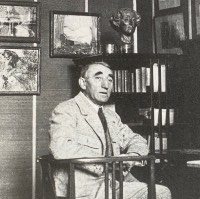THÉO VAN RYSSELBERGHE PAINTINGS FOR SALE & BIOGRAPHY
THÉO VAN RYSSELBERGHE
Belgian, 1862–1926
BIOGRAPHY
Théodore van Rysselberghe was born into a family whose members included several architects. He studied under Canneel at the academy in Ghent, and then under Portaels in Brussels. Van Rysselbeghe was extremely well-off and could afford to travel extensively, painting and exhibiting as he went. He lived for several years in Paris, spending his summers by the Channel, in accordance with the Impressionist and Neo-Impressionist custom. He participated in the establishment of the Franco-Belgian artistic exchange group Les XX (The 20) and in its various exhibitions. He was also a founder member of the Libre Esthétique movement. He exhibited at the Salon des Indépendants in Paris on several occasions. At that juncture, his painting was on the conventional side, fleshy and sombre, betraying some orientalist elements inherited perhaps from Portaels.
"Van Rysselberghe visited Spain and Morocco on several occasions from 1884, painting his Arab Storyteller and Fantasia. His colors gradually lightened and he began to emerge as a portrait artist. He was on intimate terms with Émile Verhaeren, and it was the latter who invited him to Paris, where van Rysselberghe was greatly impressed by Seurat's La Grande Jatte. He was not entirely convinced, however, by the scientific approach the Divisionists derived from the theory of colour expounded by Chevreul and espoused to a greater or lesser degree by Signac, Cross and Pissarro.
"From 1887, van Rysselberghe began painting in the Neo-Impressionist manner, becoming virtually the only artist to apply this approach to portraiture. Paintings such as Madame Oc. Ghysbrechts, Octave Maus (1885) and Madame Maus (1890) date from around this time. Van Rysselberghe also painted a number of landscapes, among them Promenade and Tartan Vessels at Sète. Around 1895, he joined Henry van de Velde in a bid to resuscitate the decorative arts. He designed posters, furniture, typographical elements and jewelry in the 'new style' and painted a large number of decorative panels specifically commissioned by architects.
"In 1898, he left Brussels and settled in Paris, where he moved in Symbolist literary circles. His wife - 'Madame Théo' or 'The Little Lady' - played an important role in the life of André Gide. In 1903, van Rysselberghe painted his celebrated Reading, where a large number of writers are depicted in a group surrounding Verhaeren, including Gide, Maeterlinck and Fénéon. He continued to paint essentially in the Neo-Impressionist manner, using visual effects achieved by juxtaposed patches of colour, with a predominance of violets, mauves and blues. While residing at St-Clair in Provence, however, he felt a need for a greater repertoire in terms of technique and color. He duly abandoned the strict tenets of Neo-Impressionism and began painting in the Fauvist manner, using more intense colors in his seascapes and bathing scenes, where the female bathers' bodies are fleshed out by the strong colors of sea and sun" (Benezit, Dictionary of Artists, Paris, 2006).
Museum Collections:
Art Institute of Chicago, Chicago, IL
Cleveland Museum of Art, Clev
Harvard University Art Museums, Cambridge, MA
Indianapolis Museum of Art, Indianapolis, IN
Metropolitan Museum of Art, New York, NY
Musée d'Orsay, Paris
Museum of Fine Arts, Boston, MA
Museum of Modern Art, New York, NY
National Gallery, London
National Gallery of Art, Washington, D.C.
National Portrait Gallery, London
Neue Pinakothek, Munich
Phoenix Art Museum, Phoenix, AZ
Royal Museum of Fine Arts, Antwerp
Thyssen-Bornemisza Museum, Madrid
Mark Murray Fine Paintings is a New York gallery specializing in buying and selling 19th century and early 20th century artwork.
THÉO VAN RYSSELBERGHE
Paintings for sale
Currently there are no available Théodore van Rysselberghe paintings for sale at the Mark Murray Gallery.
Please contact us if you are interested in selling your Théodore van Rysselberghe paintings or other artwork from the 19th century and early 20th century.
Théo Van Rysselberghe Paintings Previously Sold
THÉO VAN RYSSELBERGHE
A Windmill (1916)
Oil on board
8½ x 10½ inches (21.5 x 26.5 cm.)
SOLD
THÉO VAN RYSSELBERGHE
L'Escalier
Pencil and watercolor on paper
13¾ x 17½ inches (35 x 44.5 cm)
SOLD



